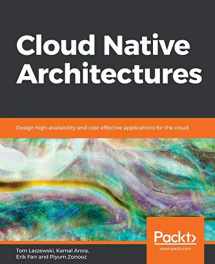
Cloud Native Architectures
Book details
Summary
Description
Learn and understand the need to architect cloud applications and migrate your business to cloud efficiently
Key Features- Understand the core design elements required to build scalable systems
- Plan resources and technology stacks effectively for high security and fault tolerance
- Explore core architectural principles using real-world examples
Cloud computing has proven to be the most revolutionary IT development since virtualization. Cloud native architectures give you the benefit of more flexibility over legacy systems. To harness this, businesses need to refresh their development models and architectures when they find they don't port to the cloud. Cloud Native Architectures demonstrates three essential components of deploying modern cloud native architectures: organizational transformation, deployment modernization, and cloud native architecture patterns.
This book starts with a quick introduction to cloud native architectures that are used as a base to define and explain what cloud native architecture is and is not. You will learn what a cloud adoption framework looks like and develop cloud native architectures using microservices and serverless computing as design principles. You'll then explore the major pillars of cloud native design including scalability, cost optimization, security, and ways to achieve operational excellence. In the concluding chapters, you will also learn about various public cloud architectures ranging from AWS and Azure to the Google Cloud Platform.
By the end of this book, you will have learned the techniques to adopt cloud native architectures that meet your business requirements. You will also understand the future trends and expectations of cloud providers.
What you will learn- Learn the difference between cloud native and traditional architecture
- Explore the aspects of migration, when and why to use it
- Identify the elements to consider when selecting a technology for your architecture
- Automate security controls and configuration management
- Use infrastructure as code and CICD pipelines to run environments in a sustainable manner
- Understand the management and monitoring capabilities for AWS cloud native application architectures
Cloud Native Architectures is for software architects who are keen on designing resilient, scalable, and highly available applications that are native to the cloud.
Table of Contents- Introducing Cloud Native Architecture
- The Cloud Adoption Journey
- Cloud Native Application Design
- How to Choose Technology Stacks
- Scalable and Available
- Secure and Reliable
- Optimizing Cost
- Cloud Native Operations
- Amazon Web Services
- Microsoft Azure
- Google Cloud Platform
- What's Next? Cloud Native Application Architecture Trends


We would LOVE it if you could help us and other readers by reviewing the book
Book review



